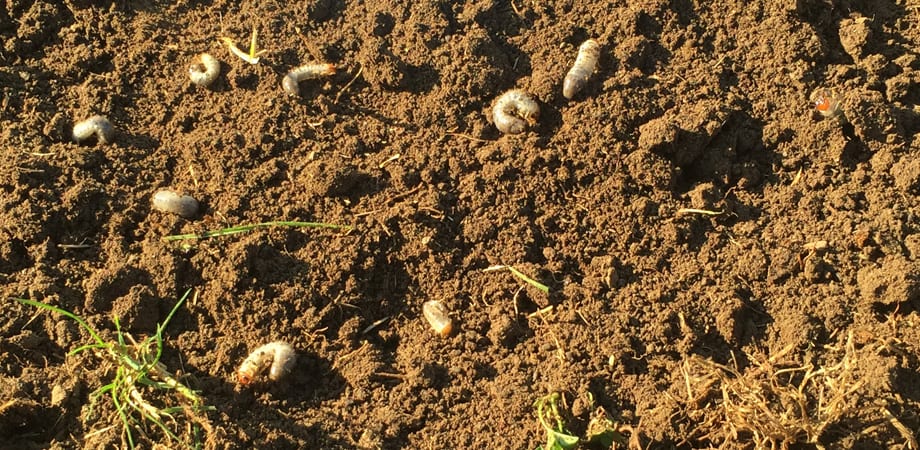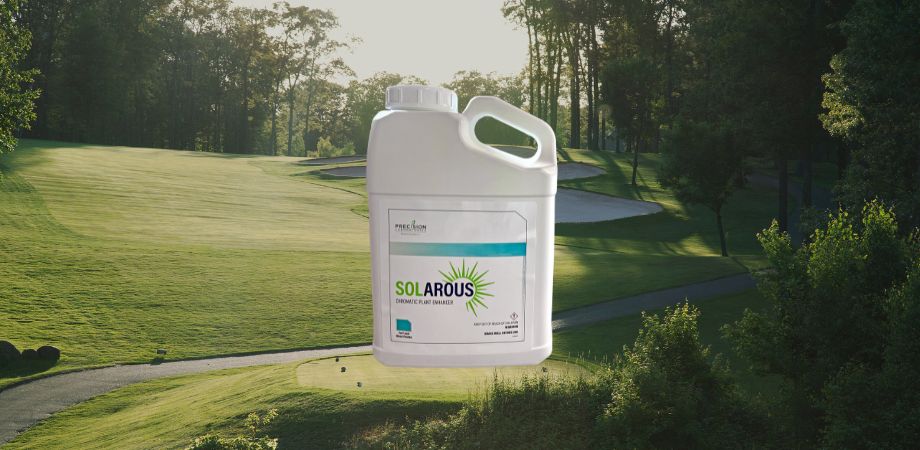Simply put, grubs feed on the roots of turfgrass—and that’s bad.
Grubs are the larval form of different types of scarab beetles, and they make themselves known during mid-summer and early fall, for the most part. Unfortunately, if you had them last season, there’s a good chance you will again. The reason: Your healthy, well-irrigated turf is something they like (and like to come back to) to lay their eggs in since they need water to hatch. They think of your turf as their family estate, and it’s in your best interest to evict them before they trash the place.
Grub 101
Here’s a basic overview of the beetle lifecycle: An egg hatches, takes larval form, then takes pupal form, and then becomes an adult. The larval form is when they are referred to as grubs.
Once the beetle is in adult form, it crawls out of the soil, flies into the air, finds a mate, and lays its eggs in the soil. Remember that it’s easy for them to dig/crawl into healthy turfgrass. Couple that with the fact that moist conditions are optimal for hatching (dry summers often tend to have less damage due to fewer eggs hatching) and we have a recipe for a potential infestation.
As you prepare your 2024 grub control strategy, first, assess your history. Here are some questions to ask yourself:
Do you have a history of grub problems?
This sounds like a no-brainer, but bear with us. You may have had a grub problem without even knowing it. If you do have a known history of grub problems, you’re likely familiar with the following, and if you’re not sure and these sound familiar, it’s likely that you have a history of grub problems:
If you’ve had brown patches, sponge-like turf (wet and mushy, even when it hasn’t rained), or you can peel your turf up like a welcome mat, those are telltale signs of a grub infestation. From aesthetics to walkability, grubs are detrimental to every aspect of your turf. Damage often isn’t noticed until rainfall since it can also look like drought stress.
Have grubs popped up in large quantities? Is breakthrough common?
If you peel up your turf and can see a lot of grubs in the soil (five or six per square foot), your turf is infested and the root system has been destroyed. The species may vary, and so does the damage they do. Masked chafers and Japanese beetles are common.
If your turf does not peel up, and after taking a sample you see just one or two, it’s not infested and there is minimal risk to your turf. If your turf is infested, we’ll talk more about treatment methods in the next section.
Do animals dig up your turf?
This one is a bit less obvious. If birds and small mammals are tearing up your turf like an all-you-can-eat buffet, you probably have a grub problem. From finches to raccoons, the fauna in your area are attracted to grubs—and they’ll do anything to get to them.
Once you’ve answered these questions, you probably know if you’ve had grub problems before. We scratched the surface on the big issues these small creatures can cause, but here’s the prognosis: When the root system is damaged by grubs, it can lead to major issues, including:
- Overall poor health in the form of weakened turfgrass, making it susceptible to drought and prone to disease and weeds.
- No root system. Without a functioning root system, turf will most likely die. A lack of root systems can affect maintenance practices, too. You will not be able to aerate in the fall because what’s left will be heavily damaged. In the places where the grass is rolling up, there are no roots left. There’s nothing to hold it down if you plug it.
Those are the signs of damage, but what methods can you use to mitigate the threat of grubs before they strike? Here’s what you should consider when planning your 2024 grub control plan:
Applying Grub Prevention and Control
Think about timing. Grubs typically pop up right in the middle of the summer season, usually after water is introduced to the area. Once their eggs hatch, the grubs (larvae) start eating the roots, which is when you’ll start seeing the negative effects on your turf.
An ounce of prevention is better than a gallon of cure. Applying grub prevention in the early summer (July-August) will ensure the larvae don’t have a chance to turn your turf into a tasty meal. If you did not apply a preventative and you start to see signs of damage—like brown spots—or the insect itself, it’s time to treat the area as soon as possible. Sticking to a schedule will help you stay ahead of potential damage.
Ask yourself these questions when you’re planning treatments:
- Do I want to use a liquid or granular? Both have their benefits and are effective treatment options.
- What equipment do I have and does it fit with the product I want to use? If using a liquid product, use a minimum of 1 gallon of water per thousand square feet. Spread as opposed to spraying to get the necessary water volume, as a certain water volume is needed to get the product into the root zone. Are you using specialized equipment on a large area or are you using a basic spreader on a small area? Be sure to tailor your strategy and be realistic.
- Do I want to be proactive or reactive? Should I put down preventative or do a curative application? We recommend a preventative. Curative applications will be effective, but damage will already be done. It can also be more costly. A preventative will save money in the long run, because if you end up with an issue, you may have to reseed.
Consult an ATS representative or another trusted professional for best practices. Your ATS rep can guide you on your choice of product and the best timing for your area.
Cultural practices to consider
Some articles may recommend introducing beneficial nematodes, milky spore, topdressing, and more, but they are geared more towards individual homeowners and their efficacy in a commercial application will likely be minimal.
At the end of the day, having healthy turf will help it recover. Many of our turfgrasses, like Advanced RPR coated with Foliar-Pak XCD, are endophyte enhanced, which means they have additional stress tolerance and might help with grub control. If you have a high enough grub population, however, their efficacy will be limited.
Products to consider
Should you use the same preventative product as last year or something new? Liquid or granular? Truly, it really doesn’t matter, but be sure to find something that contains diamides or neonicotinoids—that’s what kills the grubs.
Some products to consider include:
Merit 75 WSP by Envu
- Contains: Imidacloprid
- Form: Liquid
- Application: July-August
Arena 50 WDG by NuFarm
- Contains: Clothianidin
- Form: Liquid, also comes in granular
- Application: July-August
22-0-7, .067% Acelypryn by The Andersons
- Contains: Acelepryn
- Form: Granular
- Application: April-May
Tetrino by Envu
- Contains: Tetraniliprole
- Form: Liquid
- Application: July-August
Durentis by FMC
- Contains: Chlorantraniliprole
- Form: Liquid
- Application: April-June
Before you choose a product, be sure to get a professional opinion based on your geographic location, turf condition, type of turf, and more. Not sure where to go? One of our helpful representatives will help you find the product that’s right for your turfgrass.












